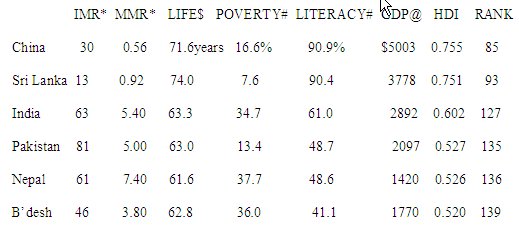The United Nations Development Programme's Human Development Index (HDI) was created by the late Mahbub ul Haq and by Amartya Sen on a scale of zero-to-one to mathematically represent a country's human indicators in terms of life expectancy, income generation and literacy. Since the methodology used is common across all countries, the index is an excellent means of comparing human indicators across national boundaries. In the latest annual rankings of nations based on this index, India has retained its previous position - 127 out of the 177 countries considered. In South Asia, Sri Lanka is the only country in the top 100 nations; it is ranked 96. Pakistan, Nepal and Bangladesh are at 135, 136 and 139 respectively.
Some important parameters are listed in the Table below. China has been included for reference. All figures in the Table are taken from the UNDP Report released on 7 September this year.

* Infant/Maternal Mortality Rate per thousand live births.
|
The index is simply a decimal value by which to rank countries and study trends. To evaluate the HDI, one needs to go into its specifics. For example, the infant mortality rate (IMR) in South Asia varies widely between 13 per thousand live births in Sri Lanka and 81 in Pakistan; it is 63 in India, 61 in Nepal and 46 in Bangladesh. China has an IMR of 30. The IMR is one of the parameters used for working out the life expectancy index. What does this mean, in terms of number of children? Based on a population of 1.1 billion and a birth rate of 24 per thousand, we know that roughly 26 million children are born each year in India. Of these, nearly 1.64 million children will will die before they reach the age of one. If our IMR were instead 46 (the number in Bangladesh) then the number of deaths would reduce to about 1.2 million. In other words 450,000 lives would be saved each year if we could achieve the status of Bangladesh in the Infant Mortality Rate.
The gains would be even better if we reached the much higher standards of Sri Lanka or China. The Planning Commission in the Tenth Plan has outlined that we should achieve the current Bangladesh standard by 2007 and the current Chinese standard by 2012; by then those countries will probably be doing even better. The Sri Lankan achievement is very far away, our best-performing state (Kerala) has an IMR of 19, still 50% worse than Sri Lanka's average.
Similarly the maternal mortality rate (MMR) this varies between 0.92 per thousand births in Sri Lanka and 7.4 in Nepal; it is 5.4 in India, 5.0 in Pakistan and 3.8 in Bangladesh. This translates into 140,000 mothers dying each year in India due to childbirth. This figure would reduce to 24,000 if our MMR were to drop to the Sri Lankan level, a saving of more than 100,000 lives each year. The Planning Commission's goal is to reduce the MMR to 2 by 2007 and 1 by 2012. This seems almost impossible to achieve given that we are currently at a figure of 5.4.

•
Global leadership, empty stomachs
•
Rerouting the call of the needy
Several other parameters, like public spending on health and education, are also relevant and inter-related. It would be stating the obvious to say that we need to spend aggressively in these sectors. Welfare spending, however, is always held hostage to other 'priorities' identified by the government - defense and subsidies - and also the ever-increasing cost of interest payments on all our loans. The tax-to-GDP ratio is also very low. As a result, the countries that India resembles the most today are the ones in Africa we tend to dismiss as unimportant globally. The annual HDI rankings are a reminder that we are no better.
